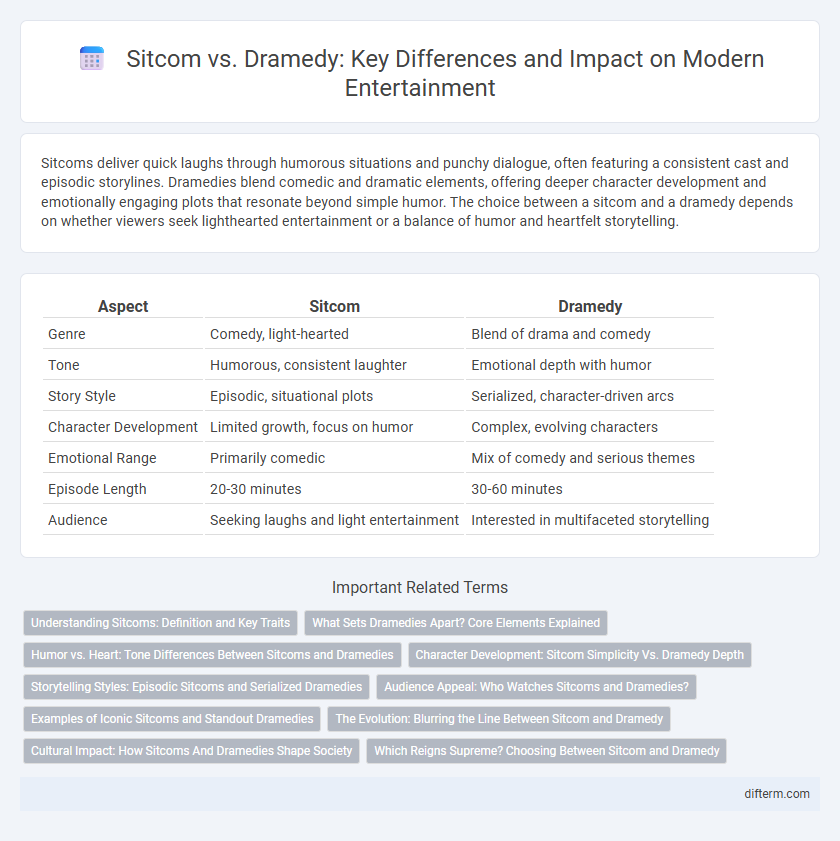Sitcoms deliver quick laughs through humorous situations and punchy dialogue, often featuring a consistent cast and episodic storylines. Dramedies blend comedic and dramatic elements, offering deeper character development and emotionally engaging plots that resonate beyond simple humor. The choice between a sitcom and a dramedy depends on whether viewers seek lighthearted entertainment or a balance of humor and heartfelt storytelling.
Table of Comparison
| Aspect | Sitcom | Dramedy |
|---|---|---|
| Genre | Comedy, light-hearted | Blend of drama and comedy |
| Tone | Humorous, consistent laughter | Emotional depth with humor |
| Story Style | Episodic, situational plots | Serialized, character-driven arcs |
| Character Development | Limited growth, focus on humor | Complex, evolving characters |
| Emotional Range | Primarily comedic | Mix of comedy and serious themes |
| Episode Length | 20-30 minutes | 30-60 minutes |
| Audience | Seeking laughs and light entertainment | Interested in multifaceted storytelling |
Understanding Sitcoms: Definition and Key Traits
Sitcoms, short for situational comedies, are characterized by humorous storylines centered around a consistent group of characters in a familiar setting, such as a family home or workplace. Key traits include episodic plots with self-contained stories, laugh tracks or live studio audiences, and exaggerated comedic situations that emphasize timing and punchlines. Unlike dramedies, sitcoms maintain a predominantly lighthearted tone, prioritizing humor over emotional depth or dramatic elements.
What Sets Dramedies Apart? Core Elements Explained
Dramedies blend comedic and dramatic elements to explore complex characters and emotional storylines, setting them apart from traditional sitcoms that rely primarily on humor and episodic plots. Core elements of dramedies include nuanced character development, realistic conflicts, and a balance between laughter and introspection. This genre appeals to audiences seeking relatable narratives with both heartfelt moments and lightheartedness.
Humor vs. Heart: Tone Differences Between Sitcoms and Dramedies
Sitcoms deliver humor through consistent laugh tracks, exaggerated characters, and episodic storylines centered on comedic situations. Dramedies balance humor with emotional depth by exploring complex characters and real-life issues, blending comedic moments with heartfelt drama. The tonal contrast lies in sitcoms prioritizing lighthearted entertainment, while dramedies emphasize nuanced storytelling that evokes both laughter and empathy.
Character Development: Sitcom Simplicity Vs. Dramedy Depth
Sitcoms prioritize quick, consistent character traits that create humor through repetition and situational comedy, often limiting deep emotional growth to maintain lighthearted entertainment. Dramedies explore multifaceted character arcs, blending comedic and dramatic elements to offer complex emotional development and realistic interpersonal dynamics. This depth in dramedy enables richer storytelling and greater audience connection through evolving character journeys.
Storytelling Styles: Episodic Sitcoms and Serialized Dramedies
Episodic sitcoms prioritize self-contained stories with humor-driven plots that reset character dynamics every episode, ensuring casual viewers can jump in at any point. Serialized dramedies employ continuous storytelling arcs with complex character development and emotional depth, encouraging audience investment over multiple episodes or seasons. This narrative approach in dramedies allows for nuanced exploration of themes blending comedy and drama, contrasting the lighthearted, repetitive nature of sitcoms.
Audience Appeal: Who Watches Sitcoms and Dramedies?
Sitcoms primarily attract viewers seeking lighthearted humor and predictable storylines, often appealing to families and casual audiences looking for comfort entertainment. Dramedies engage a more diverse audience interested in complex characters and emotionally nuanced narratives, blending comedic elements with dramatic depth. Viewers who prefer character-driven plots and real-life issues tend to favor dramedies, while fans of situational comedy enjoy the episodic and laugh-centric nature of sitcoms.
Examples of Iconic Sitcoms and Standout Dramedies
Iconic sitcoms such as "Friends," "The Office," and "Seinfeld" have defined the genre with their comedic timing and memorable characters, consistently delivering humor through episodic storylines. Standout dramedies like "Orange Is the New Black" and "Gilmore Girls" blend dramatic depth with comedic elements, offering nuanced portrayals of relationships and life's complexities. These series highlight the evolution of television storytelling by balancing laughter with emotional resonance.
The Evolution: Blurring the Line Between Sitcom and Dramedy
The evolution of entertainment genres has increasingly blurred the line between sitcoms and dramedies, blending humor with more serious, emotional storytelling. Classic sitcoms like "Friends" emphasized laugh tracks and episodic punchlines, whereas modern dramedies such as "Orange Is the New Black" incorporate complex character development and socially relevant themes. This hybrid approach reflects audience demand for narratives that balance comedic relief with authentic, relatable drama.
Cultural Impact: How Sitcoms And Dramedies Shape Society
Sitcoms and dramedies influence societal norms by reflecting and challenging cultural values through humor and emotional depth, respectively. Sitcoms often reinforce shared experiences and social bonds with episodic, relatable storylines, while dramedies address complex issues, fostering empathy and nuanced conversations about identity, mental health, and diversity. Both genres impact cultural discourse by shaping viewers' perspectives and promoting social awareness in popular entertainment.
Which Reigns Supreme? Choosing Between Sitcom and Dramedy
Sitcoms excel in delivering quick-witted humor and consistent character-driven laughs, making them ideal for viewers seeking light-hearted entertainment with familiar formats. Dramedies blend comedic elements with dramatic storytelling, offering deeper emotional engagement and complex character development that appeals to audiences craving narrative depth. Choosing between sitcoms and dramedies ultimately depends on whether the viewer prioritizes straightforward comedy and episodic resolutions or nuanced storytelling with emotional resonance.
Sitcom vs Dramedy Infographic

 difterm.com
difterm.com